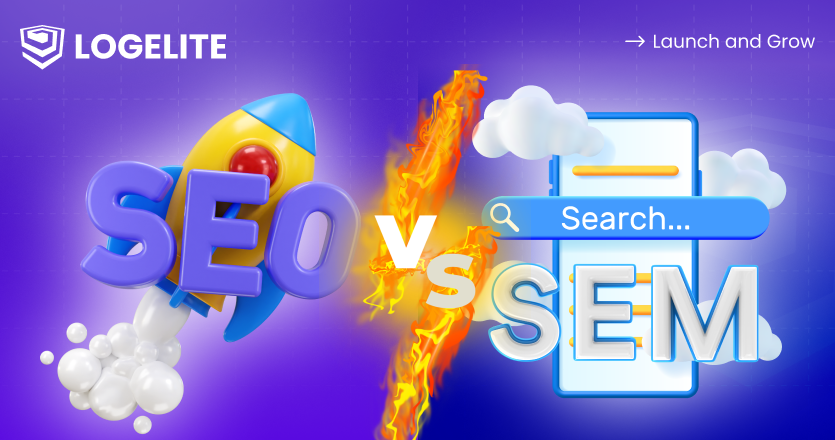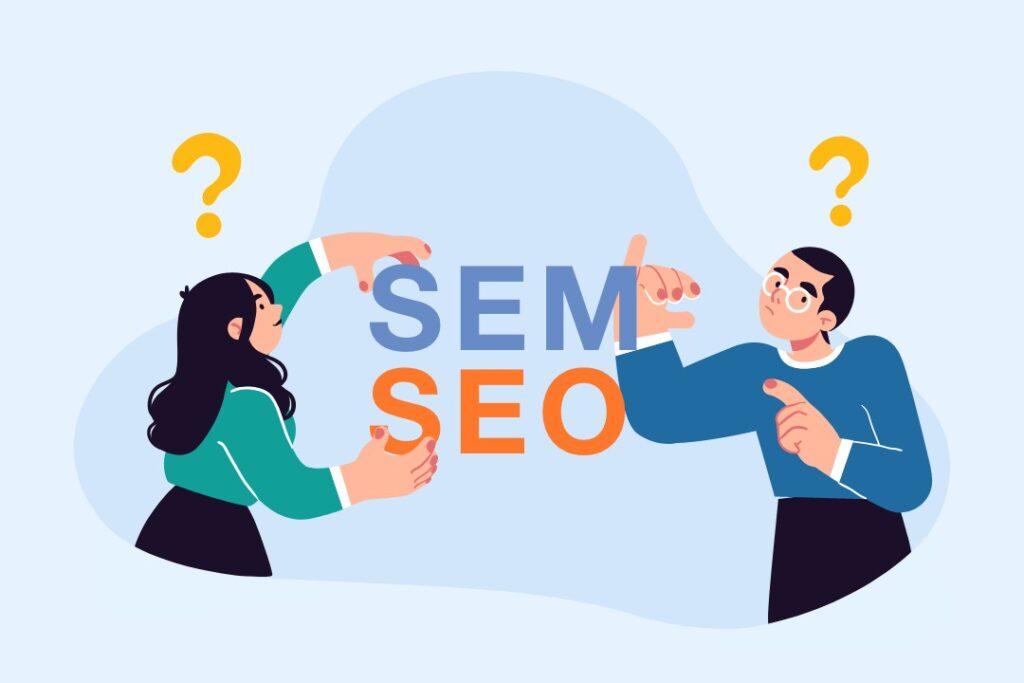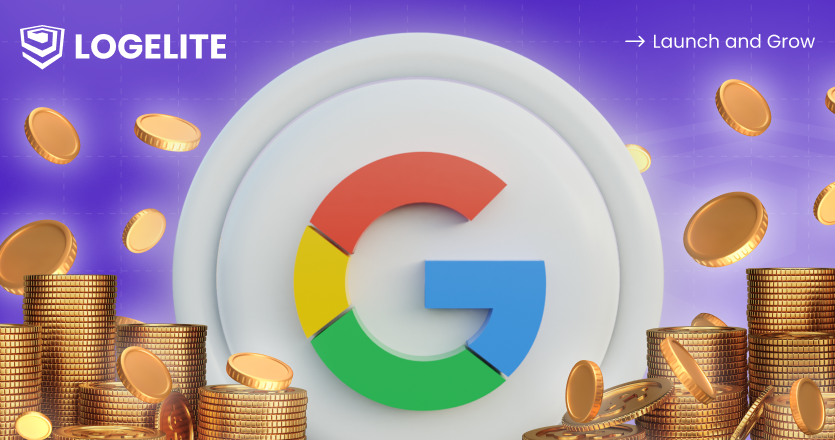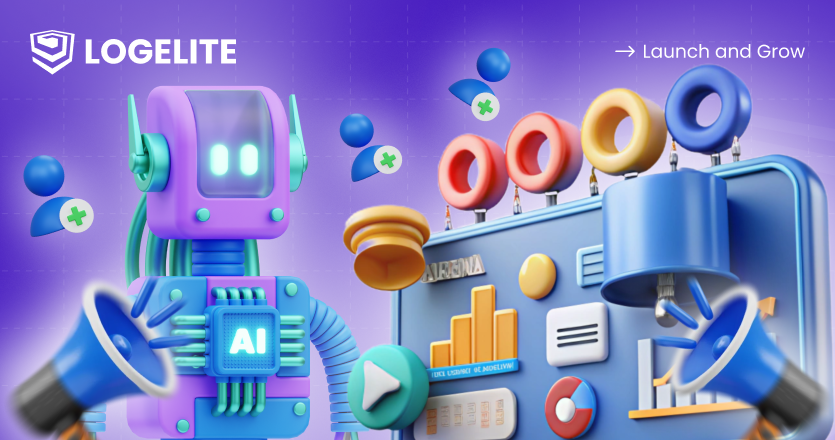
In today’s digital world, every business wants to grow online. The internet is like a big market where people search for products, services, or information every day. But how can your business stand out? How do you make sure people can find your website among so many others? This is where SEO (Search Engine Optimization) and SEM (Search Engine Marketing) can help.
These two strategies are like tools that help your site get noticed on search engines like Google. They bring more visitors to your site and can help your business grow. But which one should you choose? Should you focus on SEO, SEM, or both? In this guide, we will explain what these strategies mean and how they can help your business succeed online.
What is SEM?
Search engine marketing (SEM) is a digital marketing tactic that uses paid advertising to make websites more visible in SERPs (search engine results pages). Pay-per-click (PPC) or paid search marketing are other names for it. Paid search advertising campaigns, like Google AdWords, are commonly used in search engine marketing (SEM) to display advertisements at the top or bottom of SERPs (search engine results pages).
These advertisements are produced using particular keywords associated with the products, services, or content being provided. This strategy is a great way to find new customers, bring more visitors to your site, and get people interested in your business.
What is SEO?
SEO stands for Search Engine Optimization. It is the process of making websites, pages, and content better so they can appear higher on search engines like Google. The objective of SEO is to make it easier for users to locate and utilize various kinds of material in organic (non-paid) search results, including web pages, videos, photos, and even listings of nearby businesses.
Organic search is one of the major ways people find information online. That’s why using good SEO practices, like on-page optimization, is so important. On-page optimization means making changes to your site to improve its search rankings and make it easier for visitors to use. This can help more people find your website, stay on it longer, and enjoy the content you share.
Benefits of Choosing SEM (Search Engine Marketing)
Increases brand visibility
When you run an SEM campaign, you pay to place ads at the top of search engines. You get to pick the keywords or phrases that will show your ad below them. You may start by choosing words that match your website. Research how often people search for these words and check how much competition there is for them. These keywords are what people type into Google before they see your ad.
The biggest benefit of SEM is reaching people who are already interested in what you offer. For example, if you sell business communication tools, people searching for “best tools for business communication” are likely ready to buy. Use your ad to show how your product solves their problems and make sure they notice your brand.
Enhanced Brand Visibility
Paid search marketing works well because your ad shows up when people search for different related keywords. If your ad appears at the top of Google or on the side, people will see it and remember it. Even if they don’t click right away, your brand message will stay in their minds. This has two big effects. First, when people see your brand in multiple places, they will start to trust it.
They will notice your business showing up again and again as they search for answers to their problems. Over time, they will see you as a reliable and professional option. Second, your brand will stay in their memory for the future. Even if they choose a competitor now, they will remember your ad, your colors, and your design. When they need something the competitor doesn’t offer or want to try something new, your business will be the first one they think of.
Managing budgets in your hands
Many online marketing tools don’t let you control how much you spend. You pay a set amount and get the content it covers. The ad or blog post is then posted online, and it gets whatever traffic it gets. Sometimes, you might spend too much on SEO campaigns that don’t bring good results. With other paid ads, your ad could do well, but it might go over your budget. SEM ads solve this problem because you set your spending limit before starting.
When you upload your ad to Google and bid on keywords, you can choose how much money you want to spend on the campaign. Pay-per-click ads only charge you when someone clicks on your ad, so you are paying for real results. Once your budget runs out, Google stops running the ad until you add more money. This way, there are no surprise costs, and your marketing campaign stays on track.
Immediate outcome
Unlike SEO, SEM ads work right away. You don’t have to wait 6-12 months to see results. Instead, your brand message reaches your audience instantly. Pay-per-click (PPC) ads help you get quick results and fast conversions.
This is very important for all businesses, especially startups. Startups need customers quickly to get off to a strong start. Using PPC ads means you can make money right away and helps your business grow from the very beginning.
Enhanced Social Media Engagement
Linking your SEM ads to your social media pages can help you get more followers and engagement. When people click on your ads and visit your social media, they are more likely to follow and interact with your brand.
This is a great way to reach more people and build a stronger online presence. Having a good social media presence can also help improve your brand’s reputation and build better relationships with customers.
Increased Return on Investment
When done right, SEM can give businesses a good return on investment. If you choose the right keywords and set a budget, your businesses can make sure they get the most from their ad money.
This is really helpful for small businesses or startups that don’t have a lot to spend on marketing. With SEM, you may also track how well your ads are doing so you can keep improving and getting better results.
Benefits of choosing SEO (Search Engine Optimization)
Enhance visibility and improve rankings
One big job of SEO is to help more people see your website. This means making it simple for people to find you when they search for something you offer. Being easy to find is linked to how high you rank on search engine result pages (SERPs). The higher your website shows up on the results page, the more likely people will click on it and visit your site. That’s why it’s important to improve your organic ranking.
Gives You A Competitive Benefits
Your competitors are probably using SEO, so you should, too. Businesses that spend more on SEO often rank higher on SERP (search engine result pages) and get more customers. Since over 90% of people click on results from the first page of Google, it’s important to show up there, especially if your competitors are already there. To start, find out who your competitors are.
Look at what they are good at and where they fall short. Work on building a strong online reputation. You must make sure your site loads quickly, works well on phones, and has great content. Most importantly, focus on giving visitors the best experience when they visit your site.
Help You Reach More People
Most marketing plans focus on a specific group of people, but SEO can bring in anyone searching for what you offer. It doesn’t matter where they are in the buying process. Instead of focusing on age or location as ads do, SEO uses keywords to attract more people who might want to work with you. You may begin by making a list of keywords you want to rank for.
Then, use tools to find even more related keywords. After that, check out your competitors. You must see what keywords they rank for and where their backlinks come from. Use this information to build a stronger SEO plan that works better for your business.
Boosts Your Ranking in Local Search Results
Local searches like “plumbers near me” are becoming more popular. About 80 percent of local searches on mobile devices turn into sales or actions. Using local SEO can help you reach these people who are often ready to make a purchase. To get started with local SEO, set up a Google My Business account. Ask your customers to leave reviews, as this builds trust.
Make sure your business name, address, and phone number are correct and up to date. Also, focus on voice search by writing simple and helpful content that answers common questions. Other tips include choosing the right local keywords and adding your business to local directories.
Increases Website Usability
SEO helps search engines understand your site, but it also makes your website better for visitors. By creating helpful, high-quality content, speeding up your site, adding backlinks, and improving each page, you can build a great website that works well for both users and search engines. Things like having a clear site layout and easy navigation make your website easier to use. These are also important factors that search engines consider when ranking your site. A well-organized and user-friendly site benefits both your customers and your SEO efforts.
Choosing Between SEO and SEM
Deciding which strategy to use depends on your business goals, budget, and timeline.

When to choose SEM?
Generate Leads Quickly
If you need to bring in leads fast, like during a product launch or special event, SEM (Search Engine Marketing) can help you see results right away. Through targeted ads, you can get in front of the right people quickly. SEM allows you to set up ads that reach potential customers as soon as possible, helping you generate interest and get more leads in a short time. It’s a great tool when you need fast action and immediate visibility for your business or event.
Stand Out in Competitive Markets
SEM will give you that much-needed edge when competing in markets where many businesses are competing for the same keywords. It provides the payment opportunity to purchase ads at the top of search results, even if competing against another business. Therefore, you can gain notice pretty quickly if there are many competitors in your business. Under SEM, you pay for the position wherein your business appears first. This may increase the chance that customers will click on your ad and come to your website.
Target the Right Audience with SEM
One of the best things about SEM is it may target a specific group of individuals. You may select exactly who sees your ads by concentrating on factors like location, age, and interests. This ensures that your ads are shown to those who are most likely to be interested in your service or product. With the targeting options of SEM, you may make sure your marketing efforts are reaching genuine people, helping you get better outcomes from your ads.
Test Your Ads Quickly with SEM
SEM enables you to easily analyze different versions of your ads to see what is suitable for you. You may try different images, headlines, keywords, or landing pages and monitor how they perform. It makes it easier to find out which combinations bring in the most clicks and conversions. If you test ads quickly, you may adjust and increase your campaigns to get better outcomes. SEM enables you to easily change and find the most effective strategy for your business.
When to Choose SEO?
SEO is a Long-Term Plan for Success
SEO is not a quick solution but a steady, long-term plan to grow your business online. It helps you build a strong and lasting presence on search engines, which can bring more visitors to your website over time. While it may take a few months to see results, the benefits last much longer than short-term strategies like paid ads. This makes SEO a smart choice if you are looking to create a sustainable way to attract customers and grow your business steadily.
SEO Saves You Money Over Time
SEO is much more cost-effective compared to paid advertising. With ads, you have to pay every time someone clicks, but SEO brings people to your website naturally without ongoing costs. Although there’s an upfront effort to optimize your site, the results can last for years, making it a budget-friendly strategy. Over time, the traffic you get from SEO becomes your best return on investment because you aren’t constantly spending money to keep people coming to your site.
SEO Attracts the Right People to Your Website
SEO mainly helps your site show up when people search for major things related to your business. If you use the right keywords, your site will attract visitors who are already looking for the products or services you offer. These visitors are more likely to take action, like buying your product or signing up for your services. Instead of random traffic, SEO brings you the right audience, which can lead to higher sales and better connections with potential customers.
SEO Builds Your Brand’s Visibility and Trust
When your site ranks high on search engines, more people see your business. Being at the top makes your brand look reliable and professional. Over time, this increases your credibility and helps customers trust your products or services. SEO also helps people remember your brand because they keep seeing it whenever they search. When more people find your business, it builds a good reputation and makes it easier for customers to choose you over others.
SEO vs. SEM: How to choose the right one based on goals and budget
SEO and SEM are two ways to help people find your site on SERPs, but they work differently. SEO is all about improving your website so that it appears in search results for free. It is good if you have a small budget, want long-term results, and can wait a few months to see the changes. On the other hand, SEM is all about paying for ads to make your website show up at the top of SERPs.
It’s great if you need quick results, have a bigger budget, and want to test things fast. If you have enough time and less money, SEO can be a better choice for you. If you want results right away and can spend more, you may go with SEM. You may also do both together for better outcomes. Do you want to know how? Keep reading the further lines.
How to Use Both SEM and SEO Together
You may also use both strategies together, which can be very powerful for your business. Here’s how:
- You may start with SEM to get quick traffic while you work on improving your SEO.
- Use the data from SEM to see which keywords and ads work best and then use that information to improve your SEO strategy.
- Build a strong foundation with SEO so that even when you stop paying for ads, your website can still attract visitors.
- Use SEM to test your ideas and then use SEO to maintain your visibility.
Conclusion
Choosing between SEM and SEO mainly depends on what your business needs. SEM is great for quick results and immediate visibility, especially if you are launching a new product or want to stand out in a competitive market. It helps you reach the right audience fast and allows you to test your ads easily. On the other hand, SEO is a long-term strategy that helps build a strong online presence without ongoing costs.
It’s perfect for attracting the right visitors to your website and building trust over time. Many businesses choose to use both SEM and SEO together. SEM can bring in immediate traffic, while SEO works to bring in long-lasting results. By combining both, you can get the best of both worlds and help your business grow in the digital world.
FAQs (Frequently Asked Questions)
Which strategy is better for my business, SEM or SEO?
Ans: It depends on your goals. If you need quick results and want to appear at the top of search results right away, SEM is great. SEO takes longer but helps build long-term, sustainable growth for your website.
Can I use SEM and SEO together?
Ans: Yes, using both can be very effective. You can use SEM for quick traffic while you work on improving your SEO for long-term benefits.
How long does it take to see results with SEO?
Ans: SEO typically takes 3-6 months to see significant results, as it’s a long-term strategy that requires time to improve your website’s ranking.
Do I have to pay for SEM?
Ans: Yes, SEM uses paid ads. You pay every time someone clicks on your ad or when your ad is shown, depending on the type of campaign you choose.
Can SEO help my business without spending money?
Ans: Yes, SEO is a cost-effective strategy because you don’t have to pay for clicks or impressions. It takes effort and time to optimize your site, but it brings organic traffic without ongoing costs.













